eclipse搭建ssm框架
新建数据库ssm

建立数据库表user
- CREATE TABLE `user` (
- `id` int(11) NOT NULL AUTO_INCREMENT ,
- `sex` varchar(255) NULL ,
- `name` varchar(255) NULL ,
- PRIMARY KEY (`id`)
- );
新建一个Java web工程 SSM,目录结构如下
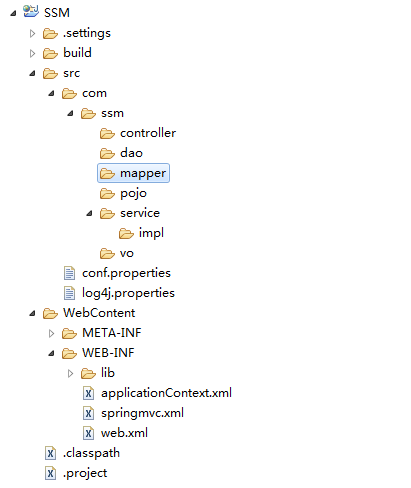
下面挨个看下配置文件
conf.properties配置详情
- url=jdbc:mysql://localhost:3306/ssm?useUnicode=true&characterEncoding=utf-8&autoReconnect=true
- driver=com.mysql.jdbc.Driver
- username=root
- password=root
log4j.properties配置详情
- log4j.rootLogger=info, live, file
- log4j.logger.org.springframework=ERROR
- log4j.logger.org.logicalcobwebs.proxool=ERROR
- log4j.appender.live=org.apache.log4j.ConsoleAppender
- log4j.appender.live.Target=System.out
- log4j.appender.live.layout=org.apache.log4j.PatternLayout
- log4j.appender.live.layout.ConversionPattern=[%-5p] %d{yyyy-MM-dd HH:mm:ss}(%r)%n--> [%t] %l: %m %x %n
- log4j.appender.file.File=/log/liveApi.log
- log4j.appender.file.layout=org.apache.log4j.PatternLayout
- log4j.appender.file=org.apache.log4j.DailyRollingFileAppender
- log4j.appender.file.layout.ConversionPattern=[%-5p] %d{yyyy-MM-dd HH:mm:ss}(%r)%n--> [%t] %l: %m %x %n
- log4j.appender.file.DatePattern='.'yyyy-MM-dd'.log'
- log4j.logger.com.ssm.dao=DEBUG
web.xml配置详情
- <?xml version="1.0" encoding="UTF-8"?>
- <web-app xmlns:xsi="http://www.w3.org/2001/XMLSchema-instance"
- xmlns="http://java.sun.com/xml/ns/javaee"
- xsi:schemaLocation="http://java.sun.com/xml/ns/javaee http://java.sun.com/xml/ns/javaee/web-app_3_0.xsd"
- id="WebApp_ID" version="3.0">
- <display-name>SSM</display-name>
- <welcome-file-list>
- <welcome-file>index.html</welcome-file>
- <welcome-file>index.htm</welcome-file>
- <welcome-file>index.jsp</welcome-file>
- <welcome-file>default.html</welcome-file>
- <welcome-file>default.htm</welcome-file>
- <welcome-file>default.jsp</welcome-file>
- </welcome-file-list>
- <!-- 配置 Spring -->
- <context-param>
- <param-name>contextConfigLocation</param-name>
- <param-value>/WEB-INF/applicationContext.xml</param-value>
- </context-param>
- <!-- 配置DispatchcerServlet -->
- <servlet>
- <servlet-name>springDispatcherServlet</servlet-name>
- <servlet-class>org.springframework.web.servlet.DispatcherServlet</servlet-class>
- <!-- 配置Spring mvc下的配置文件的位置和名称 -->
- <init-param>
- <param-name>contextConfigLocation</param-name>
- <param-value>/WEB-INF/springmvc.xml</param-value>
- </init-param>
- <load-on-startup>1</load-on-startup>
- </servlet>
- <servlet-mapping>
- <servlet-name>springDispatcherServlet</servlet-name>
- <url-pattern>/</url-pattern>
- </servlet-mapping>
- <!-- spring Web MVC框架提供了org.springframework.web.filter.CharacterEncodingFilter用于解决POST方式造成的中文乱码问题 -->
- <filter>
- <filter-name>encodingFilter</filter-name>
- <filter-class>org.springframework.web.filter.CharacterEncodingFilter</filter-class>
- <init-param>
- <param-name>encoding</param-name>
- <param-value>UTF-8</param-value>
- </init-param>
- <!-- force强制,促使 -->
- <init-param>
- <param-name>forceEncoding</param-name>
- <param-value>true</param-value>
- </init-param>
- </filter>
- <filter-mapping>
- <filter-name>encodingFilter</filter-name>
- <url-pattern>/</url-pattern>
- </filter-mapping>
- <!-- Spring监听器 -->
- <listener>
- <listener-class>org.springframework.web.context.ContextLoaderListener</listener-class>
- </listener>
- <!-- 防止Spring内存溢出监听器 -->
- <listener>
- <listener-class>org.springframework.web.util.IntrospectorCleanupListener</listener-class>
- </listener>
- <!-- 异常页面捕获 -->
- <error-page>
- <exception-type>java.lang.Throwable</exception-type>
- <location>/500.html</location>
- </error-page>
- <error-page>
- <error-code>500</error-code>
- <location>/500.html</location>
- </error-page>
- <error-page>
- <error-code>404</error-code>
- <location>/404.html</location>
- </error-page>
- </web-app>
applicationContext.xml配置详情
- <?xml version="1.0" encoding="UTF-8"?>
- <beans xmlns="http://www.springframework.org/schema/beans"
- xmlns:xsi="http://www.w3.org/2001/XMLSchema-instance" xmlns:mvc="http://www.springframework.org/schema/mvc"
- xmlns:context="http://www.springframework.org/schema/context"
- xmlns:aop="http://www.springframework.org/schema/aop" xmlns:tx="http://www.springframework.org/schema/tx"
- xsi:schemaLocation="http://www.springframework.org/schema/beans
- http://www.springframework.org/schema/beans/spring-beans-3.0.xsd
- http://www.springframework.org/schema/mvc
- http://www.springframework.org/schema/mvc/spring-mvc-3.0.xsd
- http://www.springframework.org/schema/context
- http://www.springframework.org/schema/context/spring-context-3.0.xsd
- http://www.springframework.org/schema/aop
- http://www.springframework.org/schema/aop/spring-aop-3.0.xsd
- http://www.springframework.org/schema/tx
- http://www.springframework.org/schema/tx/spring-tx-3.0.xsd ">
- <!-- 配置自动扫描的包 -->
- <context:component-scan base-package="com.ssm">
- <!-- 制定扫包规则 ,扫描除去使用@Controller注解的JAVA类 -->
- <context:exclude-filter type="annotation"
- expression="org.springframework.stereotype.Controller" />
- </context:component-scan>
- <!-- ===========================数据源配置=============================== -->
- <!-- 引入外部数据源配置信息 -->
- <bean
- class="org.springframework.beans.factory.config.PropertyPlaceholderConfigurer">
- <property name="locations">
- <value>classpath:conf.properties</value>
- </property>
- </bean>
- <!-- 配置数据源 -->
- <bean name="dataSource" class="com.alibaba.druid.pool.DruidDataSource"
- init-method="init" destroy-method="close">
- <property name="driverClassName" value="${driver}" />
- <property name="url" value="${url}" />
- <property name="username" value="${username}" />
- <property name="password" value="${password}" />
- <!-- 初始化连接大小 -->
- <property name="initialSize" value="0" />
- <!-- 连接池最大使用连接数量 -->
- <property name="maxActive" value="20" />
- <!-- 连接池最小空闲 -->
- <property name="minIdle" value="0" />
- <!-- 获取连接最大等待时间 -->
- <property name="maxWait" value="60000" />
- <property name="validationQuery">
- <value>SELECT 1</value>
- </property>
- <property name="testOnBorrow" value="false" />
- <property name="testOnReturn" value="false" />
- <property name="testWhileIdle" value="true" />
- <!-- 配置间隔多久才进行一次检测,检测需要关闭的空闲连接,单位是毫秒 -->
- <property name="timeBetweenEvictionRunsMillis" value="60000" />
- <!-- 配置一个连接在池中最小生存的时间,单位是毫秒 -->
- <property name="minEvictableIdleTimeMillis" value="25200000" />
- <!-- 打开removeAbandoned功能 -->
- <property name="removeAbandoned" value="true" />
- <!-- 1800秒,也就是30分钟 -->
- <property name="removeAbandonedTimeout" value="1800" />
- <!-- 关闭abanded连接时输出错误日志 -->
- <property name="logAbandoned" value="true" />
- <!-- 监控数据库 -->
- <!-- <property name="filters" value="stat" /> -->
- <property name="filters" value="mergeStat" />
- </bean>
- <!-- 配置MyBatis session工厂 -->
- <bean id="sqlSessionFactory" class="org.mybatis.spring.SqlSessionFactoryBean">
- <property name="dataSource" ref="dataSource" />
- <!-- 自动扫描mapping.xml文件 -->
- <property name="mapperLocations" value="classpath:com/ssm/mapper/*.xml"></property>
- </bean>
- <!-- DAO接口所在包名,Spring会自动查找其下的类 -->
- <bean class="org.mybatis.spring.mapper.MapperScannerConfigurer">
- <property name="basePackage" value="com.ssm.dao" />
- <property name="sqlSessionFactoryBeanName" value="sqlSessionFactory"></property>
- </bean>
- <!-- (事务管理)transaction manager -->
- <bean id="transactionManager"
- class="org.springframework.jdbc.datasource.DataSourceTransactionManager">
- <property name="dataSource" ref="dataSource" />
- </bean>
- <!-- 注解方式配置事物 -->
- <tx:annotation-driven transaction-manager="transactionManager" />
- </beans>
springmvc.xml配置详情
- <?xml version="1.0" encoding="UTF-8"?>
- <beans xmlns="http://www.springframework.org/schema/beans"
- xmlns:xsi="http://www.w3.org/2001/XMLSchema-instance" xmlns:context="http://www.springframework.org/schema/context"
- xmlns:mvc="http://www.springframework.org/schema/mvc" xmlns:tx="http://www.springframework.org/schema/tx"
- xmlns:task="http://www.springframework.org/schema/task"
- xsi:schemaLocation="http://www.springframework.org/schema/beans http://www.springframework.org/schema/beans/spring-beans.xsd
- http://www.springframework.org/schema/context http://www.springframework.org/schema/context/spring-context-4.0.xsd
- http://www.springframework.org/schema/mvc http://www.springframework.org/schema/mvc/spring-mvc-4.3.xsd
- http://www.springframework.org/schema/tx
- http://www.springframework.org/schema/tx/spring-tx-4.0.xsd
- http://www.springframework.org/schema/task http://www.springframework.org/schema/task/spring-task-3.0.xsd
- ">
- <!-- ====================================================== -->
- <!-- 配置@ResponseBody 保证返回值为UTF-8 -->
- <!-- 因为StringHttpMessageConverter默认是ISO8859-1 -->
- <!-- 用于使用@ResponseBody后返回中文避免乱码 -->
- <bean id="utf8Charset" class="java.nio.charset.Charset"
- factory-method="forName">
- <constructor-arg value="UTF-8" />
- </bean>
- <!-- 配置自动扫描的包 -->
- <context:component-scan base-package="com.ssm">
- <!-- 制定扫包规则 ,只扫描使用@Controller注解的JAVA类 -->
- <context:include-filter type="annotation"
- expression="org.springframework.stereotype.Controller" />
- </context:component-scan>
- <!-- 启动SpringMVC的注解功能,完成请求和注解POJO的映射 -->
- <mvc:annotation-driven>
- <mvc:message-converters register-defaults="true">
- <!-- 配置Fastjson支持 -->
- <bean
- class="com.alibaba.fastjson.support.spring.FastJsonHttpMessageConverter">
- <property name="charset" value="UTF-8" />
- <property name="supportedMediaTypes">
- <list>
- <value>text/html;charset=UTF-8</value>
- <value>application/json</value>
- <value>application/xml;charset=UTF-8</value>
- </list>
- </property>
- <property name="features">
- <list>
- <!-- 输出key时是否使用双引号 -->
- <value>QuoteFieldNames</value>
- <!-- 是否输出值为null的字段 -->
- <!-- <value>WriteMapNullValue</value> -->
- <!-- 数值字段如果为null,输出为0,而非null -->
- <value>WriteNullNumberAsZero</value>
- <!-- List字段如果为null,输出为[],而非null -->
- <value>WriteNullListAsEmpty</value>
- <!-- 字符类型字段如果为null,输出为"",而非null -->
- <value>WriteNullStringAsEmpty</value>
- <!-- Boolean字段如果为null,输出为false,而非null -->
- <value>WriteNullBooleanAsFalse</value>
- <!-- null String不输出 -->
- <value>WriteNullStringAsEmpty</value>
- <!-- null String也要输出 -->
- <!-- <value>WriteMapNullValue</value> -->
- <!-- Date的日期转换器 -->
- <value>WriteDateUseDateFormat</value>
- </list>
- </property>
- </bean>
- </mvc:message-converters>
- </mvc:annotation-driven>
- <!-- 文件上传配置 -->
- <bean id="multipartResolver"
- class="org.springframework.web.multipart.commons.CommonsMultipartResolver">
- <property name="defaultEncoding">
- <value>UTF-8</value>
- </property>
- <property name="maxUploadSize">
- <!-- 100M 1024 * 1024 * 100 -->
- <value>104857600</value>
- </property>
- <property name="maxInMemorySize">
- <value>4096</value>
- </property>
- </bean>
- </beans>
==============顺便介绍一下数据库逆向生成工具(网上应该也有现成的)================================start
新建一个java 工程generatorSqlmapCustom,如下图所示
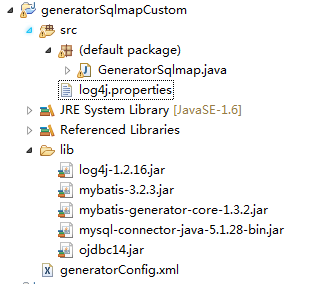
generatorConfig.xml配置详情
- <?xml version="1.0" encoding="UTF-8"?>
- <!DOCTYPE generatorConfiguration
- PUBLIC "-//mybatis.org//DTD MyBatis Generator Configuration 1.0//EN"
- "http://mybatis.org/dtd/mybatis-generator-config_1_0.dtd">
- <generatorConfiguration>
- <context id="testTables" targetRuntime="MyBatis3">
- <commentGenerator>
- <!-- 是否去除自动生成的注释 true:是 : false:否 -->
- <property name="suppressAllComments" value="true" />
- </commentGenerator>
- <!--数据库连接的信息:驱动类、连接地址、用户名、密码 -->
- <jdbcConnection driverClass="com.mysql.jdbc.Driver"
- connectionURL="jdbc:mysql://localhost:3306/ssm" userId="root"
- password="root">
- </jdbcConnection>
- <!-- 默认false,把JDBC DECIMAL 和 NUMERIC 类型解析为 Integer,为 true时把JDBC DECIMAL 和
- NUMERIC 类型解析为java.math.BigDecimal -->
- <javaTypeResolver>
- <property name="forceBigDecimals" value="false" />
- </javaTypeResolver>
- <!-- targetProject:生成PO类的位置 -->
- <javaModelGenerator targetPackage="com.ssm.pojo"
- targetProject=".\src">
- <!-- enableSubPackages:是否让schema作为包的后缀 -->
- <property name="enableSubPackages" value="false" />
- <!-- 从数据库返回的值被清理前后的空格 -->
- <property name="trimStrings" value="true" />
- </javaModelGenerator>
- <!-- targetProject:mapper映射文件生成的位置 -->
- <sqlMapGenerator targetPackage="com.ssm.dao"
- targetProject=".\src">
- <!-- enableSubPackages:是否让schema作为包的后缀 -->
- <property name="enableSubPackages" value="false" />
- </sqlMapGenerator>
- <!-- targetPackage:mapper接口生成的位置 -->
- <javaClientGenerator type="XMLMAPPER"
- targetPackage="com.ssm.dao"
- targetProject=".\src">
- <!-- enableSubPackages:是否让schema作为包的后缀 -->
- <property name="enableSubPackages" value="false" />
- </javaClientGenerator>
- <!-- 指定数据库表 -->
- <table schema="" tableName="user"></table>
- </context>
- </generatorConfiguration>
GeneratorSqlmap.java代码
- public void generator() throws Exception{
- List<String> warnings = new ArrayList<String>();
- boolean overwrite = true;
- //指定 逆向工程配置文件
- File configFile = new File("generatorConfig.xml");
- ConfigurationParser cp = new ConfigurationParser(warnings);
- Configuration config = cp.parseConfiguration(configFile);
- DefaultShellCallback callback = new DefaultShellCallback(overwrite);
- MyBatisGenerator myBatisGenerator = new MyBatisGenerator(config,
- callback, warnings);
- myBatisGenerator.generate(null);
- }
- public static void main(String[] args) throws Exception {
- try {
- GeneratorSqlmap generatorSqlmap = new GeneratorSqlmap();
- generatorSqlmap.generator();
- } catch (Exception e) {
- e.printStackTrace();
- }
- }
执行main函数 生成对应的映射文件,然后刷新项目
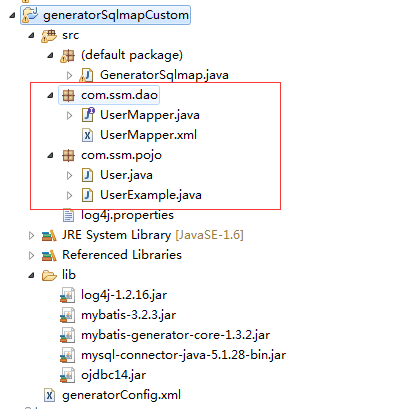
==============顺便介绍一下数据库逆向生成工具================================end
将逆向生成的文件拷贝到对应的文件夹
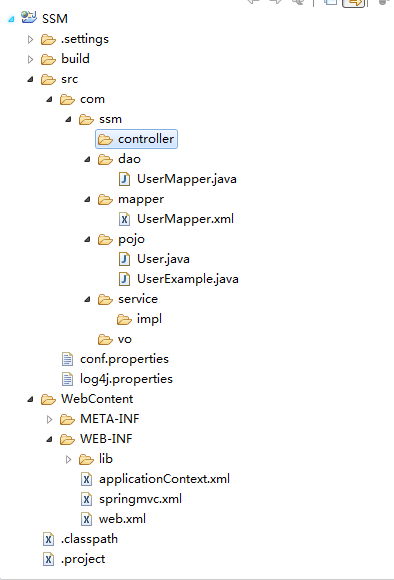
如果不想使用逆向工程,手动配置一下也可以
User.java
- package com.ssm.pojo;
- public class User {
- private Integer id;
- private String sex;
- private String name;
- public Integer getId() {
- return id;
- }
- public void setId(Integer id) {
- this.id = id;
- }
- public String getSex() {
- return sex;
- }
- public void setSex(String sex) {
- this.sex = sex == null ? null : sex.trim();
- }
- public String getName() {
- return name;
- }
- public void setName(String name) {
- this.name = name == null ? null : name.trim();
- }
- }
UserExample.java其实这个类可以没有,这个类主要就是方便配置sql查询条件
- package com.ssm.pojo;
- import java.util.ArrayList;
- import java.util.List;
- public class UserExample {
- protected String orderByClause;
- protected boolean distinct;
- protected List<Criteria> oredCriteria;
- public UserExample() {
- oredCriteria = new ArrayList<Criteria>();
- }
- public void setOrderByClause(String orderByClause) {
- this.orderByClause = orderByClause;
- }
- public String getOrderByClause() {
- return orderByClause;
- }
- public void setDistinct(boolean distinct) {
- this.distinct = distinct;
- }
- public boolean isDistinct() {
- return distinct;
- }
- public List<Criteria> getOredCriteria() {
- return oredCriteria;
- }
- public void or(Criteria criteria) {
- oredCriteria.add(criteria);
- }
- public Criteria or() {
- Criteria criteria = createCriteriaInternal();
- oredCriteria.add(criteria);
- return criteria;
- }
- public Criteria createCriteria() {
- Criteria criteria = createCriteriaInternal();
- if (oredCriteria.size() == 0) {
- oredCriteria.add(criteria);
- }
- return criteria;
- }
- protected Criteria createCriteriaInternal() {
- Criteria criteria = new Criteria();
- return criteria;
- }
- public void clear() {
- oredCriteria.clear();
- orderByClause = null;
- distinct = false;
- }
- protected abstract static class GeneratedCriteria {
- protected List<Criterion> criteria;
- protected GeneratedCriteria() {
- super();
- criteria = new ArrayList<Criterion>();
- }
- public boolean isValid() {
- return criteria.size() > 0;
- }
- public List<Criterion> getAllCriteria() {
- return criteria;
- }
- public List<Criterion> getCriteria() {
- return criteria;
- }
- protected void addCriterion(String condition) {
- if (condition == null) {
- throw new RuntimeException("Value for condition cannot be null");
- }
- criteria.add(new Criterion(condition));
- }
- protected void addCriterion(String condition, Object value, String property) {
- if (value == null) {
- throw new RuntimeException("Value for " + property + " cannot be null");
- }
- criteria.add(new Criterion(condition, value));
- }
- protected void addCriterion(String condition, Object value1, Object value2, String property) {
- if (value1 == null || value2 == null) {
- throw new RuntimeException("Between values for " + property + " cannot be null");
- }
- criteria.add(new Criterion(condition, value1, value2));
- }
- public Criteria andIdIsNull() {
- addCriterion("id is null");
- return (Criteria) this;
- }
- public Criteria andIdIsNotNull() {
- addCriterion("id is not null");
- return (Criteria) this;
- }
- public Criteria andIdEqualTo(Integer value) {
- addCriterion("id =", value, "id");
- return (Criteria) this;
- }
- public Criteria andIdNotEqualTo(Integer value) {
- addCriterion("id <>", value, "id");
- return (Criteria) this;
- }
- public Criteria andIdGreaterThan(Integer value) {
- addCriterion("id >", value, "id");
- return (Criteria) this;
- }
- public Criteria andIdGreaterThanOrEqualTo(Integer value) {
- addCriterion("id >=", value, "id");
- return (Criteria) this;
- }
- public Criteria andIdLessThan(Integer value) {
- addCriterion("id <", value, "id");
- return (Criteria) this;
- }
- public Criteria andIdLessThanOrEqualTo(Integer value) {
- addCriterion("id <=", value, "id");
- return (Criteria) this;
- }
- public Criteria andIdIn(List<Integer> values) {
- addCriterion("id in", values, "id");
- return (Criteria) this;
- }
- public Criteria andIdNotIn(List<Integer> values) {
- addCriterion("id not in", values, "id");
- return (Criteria) this;
- }
- public Criteria andIdBetween(Integer value1, Integer value2) {
- addCriterion("id between", value1, value2, "id");
- return (Criteria) this;
- }
- public Criteria andIdNotBetween(Integer value1, Integer value2) {
- addCriterion("id not between", value1, value2, "id");
- return (Criteria) this;
- }
- public Criteria andSexIsNull() {
- addCriterion("sex is null");
- return (Criteria) this;
- }
- public Criteria andSexIsNotNull() {
- addCriterion("sex is not null");
- return (Criteria) this;
- }
- public Criteria andSexEqualTo(String value) {
- addCriterion("sex =", value, "sex");
- return (Criteria) this;
- }
- public Criteria andSexNotEqualTo(String value) {
- addCriterion("sex <>", value, "sex");
- return (Criteria) this;
- }
- public Criteria andSexGreaterThan(String value) {
- addCriterion("sex >", value, "sex");
- return (Criteria) this;
- }
- public Criteria andSexGreaterThanOrEqualTo(String value) {
- addCriterion("sex >=", value, "sex");
- return (Criteria) this;
- }
- public Criteria andSexLessThan(String value) {
- addCriterion("sex <", value, "sex");
- return (Criteria) this;
- }
- public Criteria andSexLessThanOrEqualTo(String value) {
- addCriterion("sex <=", value, "sex");
- return (Criteria) this;
- }
- public Criteria andSexLike(String value) {
- addCriterion("sex like", value, "sex");
- return (Criteria) this;
- }
- public Criteria andSexNotLike(String value) {
- addCriterion("sex not like", value, "sex");
- return (Criteria) this;
- }
- public Criteria andSexIn(List<String> values) {
- addCriterion("sex in", values, "sex");
- return (Criteria) this;
- }
- public Criteria andSexNotIn(List<String> values) {
- addCriterion("sex not in", values, "sex");
- return (Criteria) this;
- }
- public Criteria andSexBetween(String value1, String value2) {
- addCriterion("sex between", value1, value2, "sex");
- return (Criteria) this;
- }
- public Criteria andSexNotBetween(String value1, String value2) {
- addCriterion("sex not between", value1, value2, "sex");
- return (Criteria) this;
- }
- public Criteria andNameIsNull() {
- addCriterion("name is null");
- return (Criteria) this;
- }
- public Criteria andNameIsNotNull() {
- addCriterion("name is not null");
- return (Criteria) this;
- }
- public Criteria andNameEqualTo(String value) {
- addCriterion("name =", value, "name");
- return (Criteria) this;
- }
- public Criteria andNameNotEqualTo(String value) {
- addCriterion("name <>", value, "name");
- return (Criteria) this;
- }
- public Criteria andNameGreaterThan(String value) {
- addCriterion("name >", value, "name");
- return (Criteria) this;
- }
- public Criteria andNameGreaterThanOrEqualTo(String value) {
- addCriterion("name >=", value, "name");
- return (Criteria) this;
- }
- public Criteria andNameLessThan(String value) {
- addCriterion("name <", value, "name");
- return (Criteria) this;
- }
- public Criteria andNameLessThanOrEqualTo(String value) {
- addCriterion("name <=", value, "name");
- return (Criteria) this;
- }
- public Criteria andNameLike(String value) {
- addCriterion("name like", value, "name");
- return (Criteria) this;
- }
- public Criteria andNameNotLike(String value) {
- addCriterion("name not like", value, "name");
- return (Criteria) this;
- }
- public Criteria andNameIn(List<String> values) {
- addCriterion("name in", values, "name");
- return (Criteria) this;
- }
- public Criteria andNameNotIn(List<String> values) {
- addCriterion("name not in", values, "name");
- return (Criteria) this;
- }
- public Criteria andNameBetween(String value1, String value2) {
- addCriterion("name between", value1, value2, "name");
- return (Criteria) this;
- }
- public Criteria andNameNotBetween(String value1, String value2) {
- addCriterion("name not between", value1, value2, "name");
- return (Criteria) this;
- }
- }
- public static class Criteria extends GeneratedCriteria {
- protected Criteria() {
- super();
- }
- }
- public static class Criterion {
- private String condition;
- private Object value;
- private Object secondValue;
- private boolean noValue;
- private boolean singleValue;
- private boolean betweenValue;
- private boolean listValue;
- private String typeHandler;
- public String getCondition() {
- return condition;
- }
- public Object getValue() {
- return value;
- }
- public Object getSecondValue() {
- return secondValue;
- }
- public boolean isNoValue() {
- return noValue;
- }
- public boolean isSingleValue() {
- return singleValue;
- }
- public boolean isBetweenValue() {
- return betweenValue;
- }
- public boolean isListValue() {
- return listValue;
- }
- public String getTypeHandler() {
- return typeHandler;
- }
- protected Criterion(String condition) {
- super();
- this.condition = condition;
- this.typeHandler = null;
- this.noValue = true;
- }
- protected Criterion(String condition, Object value, String typeHandler) {
- super();
- this.condition = condition;
- this.value = value;
- this.typeHandler = typeHandler;
- if (value instanceof List<?>) {
- this.listValue = true;
- } else {
- this.singleValue = true;
- }
- }
- protected Criterion(String condition, Object value) {
- this(condition, value, null);
- }
- protected Criterion(String condition, Object value, Object secondValue, String typeHandler) {
- super();
- this.condition = condition;
- this.value = value;
- this.secondValue = secondValue;
- this.typeHandler = typeHandler;
- this.betweenValue = true;
- }
- protected Criterion(String condition, Object value, Object secondValue) {
- this(condition, value, secondValue, null);
- }
- }
- }
- UserMapper.java
- package com.ssm.dao;
- import com.ssm.pojo.User;
- import com.ssm.pojo.UserExample;
- import java.util.List;
- import org.apache.ibatis.annotations.Param;
- public interface UserMapper {
- int countByExample(UserExample example);
- int deleteByExample(UserExample example);
- int deleteByPrimaryKey(Integer id);
- int insert(User record);
- int insertSelective(User record);
- List<User> selectByExample(UserExample example);
- User selectByPrimaryKey(Integer id);
- int updateByExampleSelective(@Param("record") User record, @Param("example") UserExample example);
- int updateByExample(@Param("record") User record, @Param("example") UserExample example);
- int updateByPrimaryKeySelective(User record);
- int updateByPrimaryKey(User record);
- }
UserMapper.xml (注意标红的地方,主键已经在数据库中设置为自动递增,所以插入sql得手动配一下)
- <?xml version="1.0" encoding="UTF-8" ?>
- <!DOCTYPE mapper PUBLIC "-//mybatis.org//DTD Mapper 3.0//EN" "http://mybatis.org/dtd/mybatis-3-mapper.dtd" >
- <mapper namespace="com.ssm.dao.UserMapper" >
- <resultMap id="BaseResultMap" type="com.ssm.pojo.User" >
- <id column="id" property="id" jdbcType="INTEGER" />
- <result column="sex" property="sex" jdbcType="VARCHAR" />
- <result column="name" property="name" jdbcType="VARCHAR" />
- </resultMap>
- <sql id="Example_Where_Clause" >
- <where >
- <foreach collection="oredCriteria" item="criteria" separator="or" >
- <if test="criteria.valid" >
- <trim prefix="(" suffix=")" prefixOverrides="and" >
- <foreach collection="criteria.criteria" item="criterion" >
- <choose >
- <when test="criterion.noValue" >
- and ${criterion.condition}
- </when>
- <when test="criterion.singleValue" >
- and ${criterion.condition} #{criterion.value}
- </when>
- <when test="criterion.betweenValue" >
- and ${criterion.condition} #{criterion.value} and #{criterion.secondValue}
- </when>
- <when test="criterion.listValue" >
- and ${criterion.condition}
- <foreach collection="criterion.value" item="listItem" open="(" close=")" separator="," >
- #{listItem}
- </foreach>
- </when>
- </choose>
- </foreach>
- </trim>
- </if>
- </foreach>
- </where>
- </sql>
- <sql id="Update_By_Example_Where_Clause" >
- <where >
- <foreach collection="example.oredCriteria" item="criteria" separator="or" >
- <if test="criteria.valid" >
- <trim prefix="(" suffix=")" prefixOverrides="and" >
- <foreach collection="criteria.criteria" item="criterion" >
- <choose >
- <when test="criterion.noValue" >
- and ${criterion.condition}
- </when>
- <when test="criterion.singleValue" >
- and ${criterion.condition} #{criterion.value}
- </when>
- <when test="criterion.betweenValue" >
- and ${criterion.condition} #{criterion.value} and #{criterion.secondValue}
- </when>
- <when test="criterion.listValue" >
- and ${criterion.condition}
- <foreach collection="criterion.value" item="listItem" open="(" close=")" separator="," >
- #{listItem}
- </foreach>
- </when>
- </choose>
- </foreach>
- </trim>
- </if>
- </foreach>
- </where>
- </sql>
- <sql id="Base_Column_List" >
- id, sex, name
- </sql>
- <select id="selectByExample" resultMap="BaseResultMap" parameterType="com.ssm.pojo.UserExample" >
- select
- <if test="distinct" >
- distinct
- </if>
- <include refid="Base_Column_List" />
- from user
- <if test="_parameter != null" >
- <include refid="Example_Where_Clause" />
- </if>
- <if test="orderByClause != null" >
- order by ${orderByClause}
- </if>
- </select>
- <select id="selectByPrimaryKey" resultMap="BaseResultMap" parameterType="java.lang.Integer" >
- select
- <include refid="Base_Column_List" />
- from user
- where id = #{id,jdbcType=INTEGER}
- </select>
- <delete id="deleteByPrimaryKey" parameterType="java.lang.Integer" >
- delete from user
- where id = #{id,jdbcType=INTEGER}
- </delete>
- <delete id="deleteByExample" parameterType="com.ssm.pojo.UserExample" >
- delete from user
- <if test="_parameter != null" >
- <include refid="Example_Where_Clause" />
- </if>
- </delete>
- <insert id="insert" parameterType="com.ssm.pojo.User" useGeneratedKeys="true" keyProperty="id">
- insert into user (sex, name
- )
- values (#{sex,jdbcType=VARCHAR}, #{name,jdbcType=VARCHAR}
- )
- </insert>
- <insert id="insertSelective" parameterType="com.ssm.pojo.User" >
- insert into user
- <trim prefix="(" suffix=")" suffixOverrides="," >
- <if test="id != null" >
- id,
- </if>
- <if test="sex != null" >
- sex,
- </if>
- <if test="name != null" >
- name,
- </if>
- </trim>
- <trim prefix="values (" suffix=")" suffixOverrides="," >
- <if test="id != null" >
- #{id,jdbcType=INTEGER},
- </if>
- <if test="sex != null" >
- #{sex,jdbcType=VARCHAR},
- </if>
- <if test="name != null" >
- #{name,jdbcType=VARCHAR},
- </if>
- </trim>
- </insert>
- <select id="countByExample" parameterType="com.ssm.pojo.UserExample" resultType="java.lang.Integer" >
- select count(*) from user
- <if test="_parameter != null" >
- <include refid="Example_Where_Clause" />
- </if>
- </select>
- <update id="updateByExampleSelective" parameterType="map" >
- update user
- <set >
- <if test="record.id != null" >
- id = #{record.id,jdbcType=INTEGER},
- </if>
- <if test="record.sex != null" >
- sex = #{record.sex,jdbcType=VARCHAR},
- </if>
- <if test="record.name != null" >
- name = #{record.name,jdbcType=VARCHAR},
- </if>
- </set>
- <if test="_parameter != null" >
- <include refid="Update_By_Example_Where_Clause" />
- </if>
- </update>
- <update id="updateByExample" parameterType="map" >
- update user
- set id = #{record.id,jdbcType=INTEGER},
- sex = #{record.sex,jdbcType=VARCHAR},
- name = #{record.name,jdbcType=VARCHAR}
- <if test="_parameter != null" >
- <include refid="Update_By_Example_Where_Clause" />
- </if>
- </update>
- <update id="updateByPrimaryKeySelective" parameterType="com.ssm.pojo.User" >
- update user
- <set >
- <if test="sex != null" >
- sex = #{sex,jdbcType=VARCHAR},
- </if>
- <if test="name != null" >
- name = #{name,jdbcType=VARCHAR},
- </if>
- </set>
- where id = #{id,jdbcType=INTEGER}
- </update>
- <update id="updateByPrimaryKey" parameterType="com.ssm.pojo.User" >
- update user
- set sex = #{sex,jdbcType=VARCHAR},
- name = #{name,jdbcType=VARCHAR}
- where id = #{id,jdbcType=INTEGER}
- </update>
- </mapper>
新建一个vo类,UserVo.java
- package com.ssm.vo;
- public class UserVo {
- private String id;
- private String sex;
- private String name;
- public String getId() {
- return id;
- }
- public void setId(String id) {
- this.id = id;
- }
- public String getSex() {
- return sex;
- }
- public void setSex(String sex) {
- this.sex = sex;
- }
- public String getName() {
- return name;
- }
- public void setName(String name) {
- this.name = name;
- }
- }
新建一个service接口,IUserService.java
- package com.ssm.service;
import java.util.Map;
import com.ssm.vo.UserVo;- public interface IUserService {
- public Map<String,String> onSave(UserVo userVo);
- }
实现IUserService接口,UserServiceImpl.java
- package com.ssm.service.impl;
- import java.util.HashMap;
- import java.util.Map;
- import org.springframework.beans.factory.annotation.Autowired;
- import org.springframework.stereotype.Service;
- import com.ssm.dao.UserMapper;
- import com.ssm.pojo.User;
- import com.ssm.service.IUserService;
- import com.ssm.vo.UserVo;
- @Service
- public class UserServiceImpl implements IUserService{
- @Autowired
- private UserMapper userMapper;
- @Override
- public Map<String, String> onSave(UserVo userVo) {
- Map<String, String> map = new HashMap<String,String>();
- try {
- User user = new User();
- user.setName(userVo.getName());
- user.setSex(userVo.getSex());
- int i = userMapper.insert(user);
- if(i > 0){
- map.put("status", "Y");
- map.put("message", "新增成功");
- }
- } catch (Exception e) {
- e.printStackTrace();
- }
- return map;
- }
- }
新建一个control类,UserController.java
- package com.ssm.controller;
- import java.util.HashMap;
- import java.util.Map;
- import org.springframework.beans.factory.annotation.Autowired;
- import org.springframework.stereotype.Controller;
- import org.springframework.web.bind.annotation.RequestMapping;
- import org.springframework.web.bind.annotation.ResponseBody;
- import com.ssm.service.IUserService;
- import com.ssm.vo.UserVo;
- @RequestMapping("/user")
- @Controller
- public class UserController {
- @Autowired
- private IUserService userService;
- @RequestMapping("/onSave")
- @ResponseBody
- public Map<String,String> onSave(UserVo userVo){
- Map<String,String> map = new HashMap<String,String>();
- try {
- map = userService.onSave(userVo);
- } catch (Exception e) {
- e.printStackTrace();
- }
- return map;
- }
- }
在WebContent目录下,新增static目录,如下图所示:
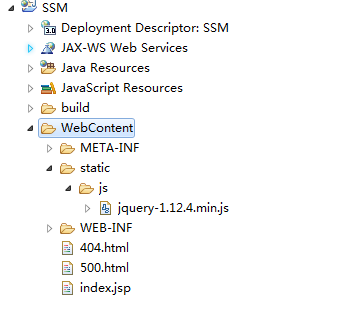
新增index.jsp页面
- <%@ page language="java" contentType="text/html; charset=UTF-8"
- pageEncoding="UTF-8"%>
- <!DOCTYPE html>
- <html>
- <head>
- <base href="${pageContext.request.contextPath}/static/"></base>
- <meta charset="utf-8" />
- <script src="js/jquery-1.12.4.min.js"></script>
- <script type="text/javascript">
- $(document).ready(function() {
- onSave();
- });
- function onSave() {
- $.ajax({
- type : "post",
- url : "${pageContext.request.contextPath}/user/onSave",
- async : false,
- timeout : 30000,
- data : {
- "sex":"男",
- "name":"张三"
- },
- dataType : 'json',
- beforeSend : function(XMLHttpRequest) {
- },
- success : function(result) {
- alert(result.message)
- },
- error : function() {
- }
- });
- }
- </script>
- </head>
- <body>
- 欢迎您!!!!!!!!!!!!!!!!
- </body>
- </html>
在浏览器地址栏,输入http://127.0.0.1:8080/SSM/index.jsp,回车,结果如下图所示

看下数据库表

eclipse搭建ssm框架的更多相关文章
- [框架]eclipse搭建ssm框架 一 标签: eclipsetomcat框架 2017-03-25 21:28 1085人阅读 评论(
虽然现在也做过一些项目,但是自己从头搭起来的框架几乎没有,所以这两天自己搭了一下ssm的框架,下面写一下框架的搭建过程.并且给出增删改查四条线来方便大家熟悉代码. 环境准备 maven3.2.3 ec ...
- 使用Eclipse搭建SSM框架(Spring + Spring MVC + Mybatis)
1.创建项目 1)打开Eclipse,点击File --> New --> Other 2)输入maven,找到Maven Project 3)然后一直按Next,直到出现一下界面: 4) ...
- eclipse搭建ssm框架的maven的工程
版本:eclipse:Indigo Service Release 2. jdk :jdk1.7.0_03. maven:apache-maven-3.3.3 . 上面的3个东西 先下载下来.然后运 ...
- Eclipse中使用Maven搭建SSM框架
Eclipse中不使用Maven搭建SSM框架:https://www.cnblogs.com/xuyiqing/p/9569459.html IDEA中使用Maven搭建SSM框架:https:// ...
- 使用Maven搭建SSM框架(Eclipse)
今天学习一下使用Maven搭建SSM框架,以前都是用别人配置好的框架写代码,今天试试自己配置一下SSM框架. 这里我的参数是Windows7 64位,tomcat9,eclipse-jee-neon- ...
- maven/eclipse搭建ssm(spring+spring mvc+mybatis)
maven/eclipse搭建ssm(spring+spring mvc+mybatis) 前言 本文旨在利用maven搭建ssm环境,而关于maven的具体内容,大家可以去阅读<Maven 实 ...
- 快速搭建ssm框架
快速搭建SSM框架 因为最近有很多朋友问我自己的项目搭建的不够完善,并且经常出现一些小问题,那么今天我又整理了一下文档教大家如何快速搭建SSM框架我是用 eclipse搭建的,如果想用idear的话我 ...
- 利用maven/eclipse搭建ssm(spring+spring mvc+mybatis)
前言 本文旨在利用maven搭建ssm环境,而关于maven的具体内容,大家可以去阅读<Maven 实战>.其实园内这方面文章已有不少,那么为什么我还要重复造轮子呢?我只是想记录自己的实践 ...
- 使用maven搭建ssm框架的javaweb项目
目前主流的javaweb项目,常会用到ssm(Spring+Spring MVC+Mybatis)框架来搭建项目的主体框架,本篇介绍搭建SSM框架的maven项目的实施流程.记之共享! 一.SSM框架 ...
随机推荐
- linux下逻辑卷管理 调整分区大小
[root@localhost ~]# df -h Filesystem Size Used Avail Use% Mounted on /dev/mapper/VolGroup-lv_root 50 ...
- appium自动化测试 环境搭建
最 近接手的项目是移动端自动化测试 ,需要用的appium ,头一回使用, 项目特点:1)数据有时效性,需要在短时间内验证大量数据, 2) 人工去一个一个核对发现不了太多BUG. 环境搭建:参考虫师的 ...
- 基于 Spring Cloud 完整的微服务架构实战
本项目是一个基于 Spring Boot.Spring Cloud.Spring Oauth2 和 Spring Cloud Netflix 等框架构建的微服务项目. @作者:Sheldon地址:ht ...
- WPF程序开发方法小总结
1.先做静态界面(静态界面带有 示例 数据---> 展示布局效果) 2.然后在VM写完之后,再对静态界面绑定数据源属性
- 20180831xlVBA_WorkbooksCosolidate
Sub WorkbooksConsolidate() Rem 设置求和区域为 sheet名称/单元格区域;sheet名称/单元格区域 Const Setting As String = "S ...
- 圆的变化(自定义动画,及自定义UI)
之前在面试的时候被问到过一个问题,如何实现一个圆沿着一条线由大到小 当时回答的含糊不清,现在已经明白怎么去实现 关键点:Paint,path,canvas 一种方法 在activity中去控制圆的x, ...
- 58Ajax
Ajax 1 .客户端浏览器通过执行一段JS代码向服务器发送请求,服务器路由对应的视图函数返回一个json字符串作为响应, 浏览器接受响应后会触发该ajax请求的回调函数success,参数为响 ...
- Django中模型层中ORM的多表操作
ORM的多表创建(一对一.一对多,多对多): 1模型创建 实例:我们来假定下面这些概念,字段和关系 作者模型:一个作者有姓名和年龄. 作者详细模型:把作者的详情放到详情表,包含生日,手机号,家庭住址等 ...
- 6月4 Smarty练习增删改
练习Smarty的增删改所需要用到的数据库名称:timu,xuanxiang,kemu,nandu,leixing,然后使用smarty模板将前端后后台分割开来: 主页后台页面:zhupm.php & ...
- sqlserver创建计算列 转
转 http://www.cnblogs.com/lgx5/p/6017874.html 表中其它列的计算值 创建的sql create table table1 ( number decimal(1 ...
